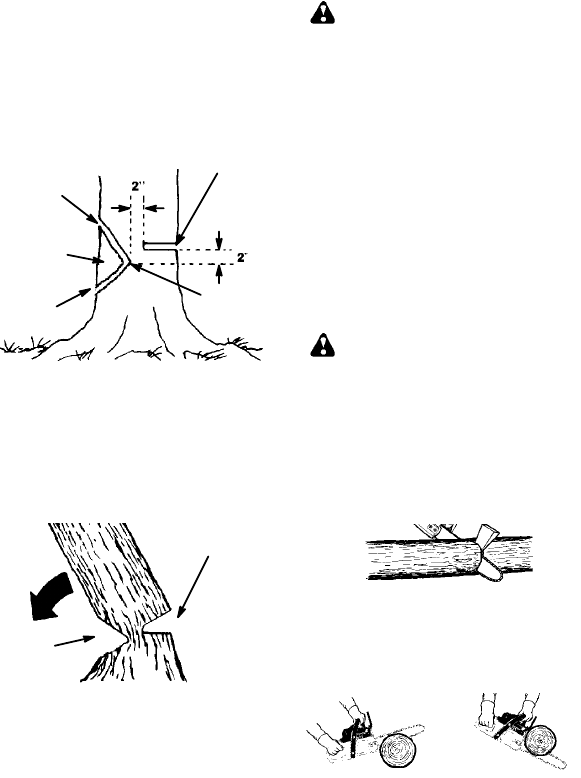
12
FELLING LARGE TREES
(6 inches (15 cm) in diameter or larger)
The notch method is used to felllarge trees.
Anotchiscutonthesideofthetreeinthede-
sired direction of fall. After a felling cut is
made on the opposite side of tree, the tree
will tend to fall into the notch.
NOTE: If the tree has large buttress roots,
removethembeforemakingthenotch. Ifus-
ing saw to remove buttress roots, keep saw
chainfromcontactinggroundtopreventdull-
ing of the chain.
NOTCH CUT AND FELL ING THE
TREE
S Make notch cut by cutting the top of the
notch first. Cut through
1/3 ofthe diameter
ofthetree.Nextcompletethenotchbycut-
ting the bottom of the notch. See illustra-
tion. Once the notch is cut remove the
notch of wood from the tree.
Notch
First cut
Second cut
Final (felling) cut here, 2 inches
(5 cm) above center of notch.
Hinge
S After removing the wood from the notch,
make the felling cut on the opposite side of
thenotch.Thisis donebymakingacutabout
two inches (5 cm) higher than the center of
thenotch. Thiswillleaveenough uncutwood
between the felling cut and thenotch to form
a hinge. This hinge will helpprevent thetree
from falling in the wrong direction.
Opening
of felling
cut
Closing of
notch
Hinge holds tree on stump and helps
control fall
NOTE: Before felling cut is complete, use
wedges to open the cut if necessary to
controlthedirectionoffall. Toavoidkickback
and chain damage, use wood or plastic
wedges, but never steel or iron wedges.
S Be alert to signs that the tree is ready to
fall: cracking sounds, widening of the fell-
ing cut, or movement in the upper
branches.
S As tree starts to fall,stop saw, putit down,
and get away quickly on your planned re-
treat path.
S DO NOT cut down a partially fallen tree
withyour saw. Beextremely cautiouswith
partially fallen trees that may be poorly
supported. When a tree doesn’t fall com-
pletely,setthesawasideandpulldownthe
tree with a cable winch, block and tackle,
or tractor.
CUTTING A FALLEN TREE
(BUCKING)
Bucking is the term used for cutting a fallen
tree to the desired log size.
WARNING: Donot standonthelog
being cut. Anyportion can roll causing loss
of footing andcontrol. Do not stand downhill
of the log being cut.
IMPORTANT POINTS
S Cut only one log at a time.
S Cut shattered w ood very carefully; s harp
pieces of wood could beflung towardopera-
tor .
S Use a sawhorse to cut small logs. Never
allow another person to hold the log while
cuttingandnever holdthelogwith yourleg
or foot.
S Do not cut in an area where logs, limbs,
and roots are tangled such as in a blown
downarea. Dragthelogs intoa cleararea
before cutting by pulling out exposed and
cleared logs first.
TYPES OF CUTTING USED FOR
BUCKING
WARNING: If saw becomes
pinched or hung in a log, don’t try to force it
out. Youcanlosecontrolofthesawresulting
ininjury and/or damageto thesaw. Stop the
saw,driveawedgeofplasticorwoodintothe
cutuntil thesaw canberemovedeasily. Re-
startthesawandcarefullyreenterthecut. To
avoid kickback and chain damage, do not
useametalwedge. Donotattempttorestart
your saw when itis pinched or hungin alog.
Use a wedge to remove pinched saw
Turn saw OFF and use a plastic or
wooden wedge to force cut open.
Overcutting begins on the top side of the log
with the bottom of the saw against the log.
When overcutting use light downward pres-
sure.
Overcutting
Undercutting
Undercuttinginvolvescuttingontheunder-
sideofthelogwithtopofsawagainstthelog.
When undercutting use light upward pres-
sure. Hold saw firmly and m aintain control.
The saw will tend to push back toward you.


















